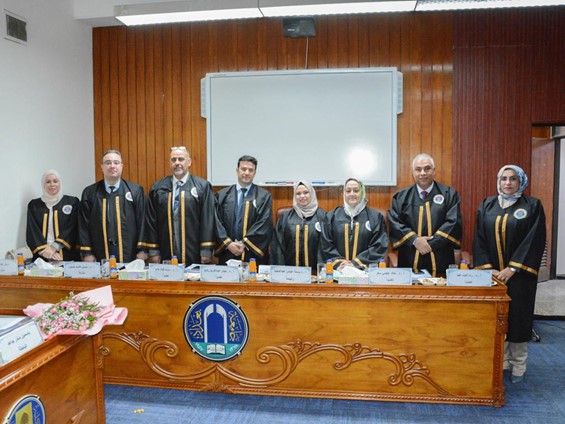The Chemical Engineering Department at the College of Engineering, University of Baghdad, held an Ph.D Dissertation examination titled:
“Deep Desulphurization of Iraqi Petroleum Fuels by Polyoxometalate-Based Ionic Liquids as Catalysts “
By the student Yasmeen Mundher Jaed and supervised by Prof. Dr. Hussein Qasim Hussein and Dr. Ban A. Al-Tabbakh. The examination committee consisted of Prof. Dr. Basma Abbas Abdulmajeed as Chairman and the membership of Prof. Dr. Khalid A. Sukkar, Prof. Dr. Hayder A. Rasheid, Asst. Prof. Dr. Sarmad Al-Anssari and Asst. Prof. Dr. Rana Thabet ABD Alrubaye. After conducting the public discussion and listening to the student’s defense, the Dissertation was accepted. The thesis was summarized as follows:
The present work deals with oxidative desulfurization of model and real diesel fuel under mild conditions using prepared hybrids organic-polyoxometalate as catalysts in the presence of ionic liquid (IL) and hydrogen peroxide (H2O2).
The first section of this work involved the preparation of the Keggin-type polyoxometalate (POM) using two kinds of quaternary ammonium salts as organic groups: tetra-butyl ammonium (TBA) bromide and octadecyl-trimethyl ammonium (ODA) bromide. The synthesized hybrids TBAPW11O39, TBAPVW11O39, and ODAPW11O39 were successfully characterized by several techniques: Fourier-transform infrared spectroscopy (FTIR), X-ray diffraction (XRD), Nuclear Magnetic Resonance spectroscopy (NMR), Field Emission Scanning Electron Microscopy (FESEM) and Energy Dispersive X-ray Spectroscope (EDX), Thermal Gravimetric Analysis (TGA) and Atomic Force Microscope (AFM).
The second section investigated the impact of the synthesized hybrid catalysts on oxidative desulfurization of model diesel fuel with a sulfur content of 300 ppm in the presence of ionic liquid in batch reactor, the ionic liquid was 1-methyl-3-octyl imidazolium hexafluorophosphate (OMIM(PF6)) type. The effects of several parameters affecting sulfur removal were studied. These parameters were (303-343)K, catalyst dosage (0.5-6) g/l, oxidant/sulfur (O/S) molar ratio (1:1 – 7:1), and IL/diesel volume ratio (1/10 – 5/10) with different times from 30-180 min.
The prepared hybrid catalysts have displayed high catalytic effectivity in removing sulfur from the model diesel. The highest sulfur removal reached 96% for TBAPW11O39 with a dosage of 3 g/l within 120 min and 80% for TBAPVW11O39 with a dosage of 9 g/l in 60 min, and 94.6% for ODAPW11O39 with a dosage of 0.5 g/l in 90 min at a temperature of 343 K, O/S = 5:1 molar ratio and IL/diese volume ratio = 2:10.
In the last section, the highly effective hybrid polyoxometalate catalysts were used with real diesel fuel under the best operating conditions, which were found by invistigating the model diesel. It was concluded that the hybrid TBAPW11O39 showed higher desulfurization efficiencies (DE) than the hybrid ODAPW11O39, which were 77.7% and 72.2%, respectively, in 120 min under similar operating conditions.
The experimental data of the oxidative desulfurization fitted with the second-order reaction kinetic model for the hybrids TBAPW11O39 and ODAPW11O39. The activation energies of oxidative desulfurization of model diesel determined by the Arrhenius equation were 31 kJ/mol and 15 kJ/mol using the hybrid catalysts TBAPW11O39 and ODAPW11O39, respectively.
The Thiele modulus (MT) and Effectiveness factor (ŋ), also identified by the correlation equations, the values of ŋ are extremely near to (1), indicating that the reaction rate and sulfur conversion are governed by intrinsic kinetics and have not been slowed by diffusional resistance.








